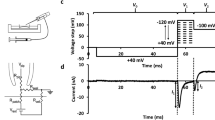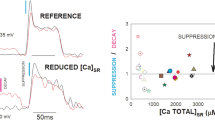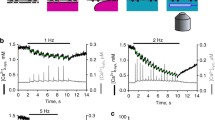Abstract
Calcium-release channels of sheep cardiac sarcoplasmic reticulum were incorporated into phosphatidylethanolamine bilayers and single channel currents were recorded under voltage-clamp conditions. The effect of adenosine on single channel conductance and gating was investigated, as were the interactions between adenosine and caffeine and adenosine and α,β-methylene ATP.
Addition of adenosine (0.5–5 mm) to the cytosolic but not the luminal side of the membrane increased the open probability of single calcium-activated calcium-release channels by increasing the frequency and duration of open events, yielding an EC50 of 0.75 mm at 10 μm activating Ca2+.
Addition of 1 mm caffeine potentiated the effects of adenosine at 10 or 100 μm-activating cytosolic calcium, but had no effect on the inability of adenosine to activate the channel at 80 pmcalcium, suggesting discrete sites of action on the calcium-release channel for adenosine and caffeine. In contrast, addition of 100 μm α,β-methylene-ATP decreased single channel open probability in the presence of adenosine, suggesting that these compounds act on the same site on the channel.
Activation of single channel opening by adenosine, or by adenosine together with caffeine, had no effect on single channel conductance or the Ca2+/Tris+ permeability ratio. Channels activated by adenosine were characteristically modified by ryanodine and blocked by μm ruthenium red or mm magnesium.
These results show that adenosine activates the sheep cardiac sarcoplasmic reticulum Ca2+-release channel by increasing the frequency and duration of open events in a Ca2+-dependent manner. The receptor site on the channel for adenosine is distinct from that for caffeine but probably the same as that for adenine nucleotides.
Similar content being viewed by others
References
Ashley, R.H., Williams, A.J. 1990. Divalent cation activation and inhibition of single calcium-release channels from sheep cardiac sarcoplasmic reticulum. J. Gen. Physiol. 95:981–1005
Blatz, A.L., Magleby, K.L. 1986. Quantitative description of three modes of activity of fast chloride channels from rat skeletal muscle. J. Physiol. 378:141–174
Chapman, R.A., Miller, D. 1974. Structure-activity relations for caffeine: a comparative study of the inotropic effects of the methylxanthines, imidazoles and related compounds on the frog's heart. J. Physiol. 242:615–634
Chu, A., Diaz-Munoz, M., Hawkes, M.J., Brush, K., Hamilton, S.L. 1990. Ryanodine as a probe for the functional state of the skeletal muscle sarcoplasmic reticulum calcium-release channel. Mol. Pharmacol. 37:735–741
Chu, A., Fill, M., Entman, M.L., Stefani, E. 1991. Different Ca2+ sensitivity of the ryanodine-sensitive Ca2+-release channels of cardiac and skeletal muscle sarcoplasmic reticulum. Biophys. J. 59:102a
Colquhoun, D., Sigworth, F. 1983. Fitting and statistical analysis of single-channel records. In: Single-Channel Recording. B. Sakmann, and E. Neher, editors, pp. 191–263. Plenum, New York
Fabiato, A. 1985. Time and calcium dependence of activation and inactivation of calcium-induced release of calcium from the sarcoplasmic reticulum of a skinned canine cardiac Purkinje cell. J. Gen. Physiol. 85:247–289
Fatt, P., Ginsborg, B.L. 1958. The ionic requirements for the production of action potentials in crustacean muscle fibres. J. Physiol. 142:516–543
Holmberg, S.R.M., Williams, A.J. 1990. The cardiac sarcoplasmic reticulum calcium-release channel: modulation of ryanodine binding and single-channel activity. Biochim. Biophys. Acta 1022:187–193
McGarry, S.J., Williams, A.J. 1993a. Digoxin activates sarcoplasmic reticulum Ca2+-release channels: a possible role in cardiac inotropy. Brit. J. Pharmacol. 108:1043–1050
McGarry, S.J., Williams, A.J. 1993b. Activation of the sheep cardiac Ca2+-release channel by analogues of sulmazole. Brit. J. Pharmacol. 108:50P
Meissner, G. 1986. Ryanodine activation and inhibition of the Ca2+ release channel of sarcoplasmic reticulum. J. Biol. Chem. 261: 6300–6306
Meissner, G., Henderson, J. S. 1987. Rapid Ca2+ release from cardiac sarcoplasmic reticulum vesicles is dependent on Ca2+ and is modulated by Mg2+, adenine nucleotides and calmodulin. J. Biol. Chem. 262:3065–3073
Miller, C. 1982. Open-state structure of single chloride channels from Torpedo electroplax. Philos. Trans. R. Soc. London B299:401–411
Olsson, R.A., Pearson, J.D. 1991. Cardiovascular purinoceptors. Physiol. Rev. 70:761–845
Palade, P. 1987. Drug-induced Ca2+ release from isolated sarcoplasmic reticulum. I. Use of pyrophosphate to study caffeine-induced Ca2+ release. J. Biol. Chem. 262:6135–6141
Pessah, I., Zimanyi, I. 1991. Characterisation of multiple [3H]ryanodine binding sites on the Ca2+ release channel of sarcoplasmic reticulum from skeletal and cardiac muscle: evidence for a sequential mechanism in ryanodine action. Mol. Pharmacol. 39:679–689
Ribeiro, J.A., Sebastiao, A.M. 1986. Adenosine receptors and calcium. Basis for proposing a third adenosine receptor. Prog. Neurobiol. 26:179–206
Rodbell M. 1983. The complex structure and regulation of adenylate cyclase. In: Regulatory Function of Adenosine. R.M. Berne, T.W. Rall, and R. Rubio, editors, pp. 3–15. Martinus Nijhoff, The Hague
Rousseau, E., Smith, J.S., Henderson, J.S., Meissner, G. 1986. Single-channel and 45Ca2+ flux measurements of the cardiac sarcoplasmic reticulum calcium channel. Biophys. J. 50:1009–1014
Rousseau, E., Ladine, J., Liu, Q.-Y., Meissner, G. 1988. Activation of the Ca2+ release channel of skeletal muscle sarcoplasmic reticulum by caffeine and related compounds. Arch. Biochem. Biophys. 267:75–86
Rousseau, E., Meissner, G. 1989. Single cardiac sarcoplasmic reticulum Ca2+-release channel: activation by caffeine. Am. J. Physiol. 256:H328-H333
Sitsapesan, R., Williams, A.J. 1991. Mechanisms of caffeine activation of single calcium-release channels of sheep cardiac sarcoplasmic reticulum. J. Physiol. 423:425–439
Smith, J.S., Coronado, R., Meissner, G. 1985. Sarcoplasmic reticulum contains adenine nucleotide-activated calcium channels. Nature 316:446–449
Tinker, A., Lindsay, A.R.G., Williams, A.J. 1992. A model for ionic conduction in the ryanodine receptor channel of sheep cardiac muscle sarcoplasmic reticulum. J. Gen. Physiol. 100:495–517
Tomlins, B., Harding, S.E., Kirby, M.S., Poole-Wilson, P.A., Williams, A.J. 1986. Contamination of a cardiac sarcolemmal preparation with endothelial plasma membrane. Biochim. Biophys. Acta 856:137–143
Williams, A.J., Holmberg, S.R.M. 1990. Sulmazole (AR-L-115BS) activates the sheep cardiac muscle sarcoplasmic reticulum calciumrelease channel in the presence and absence of calcium. J. Membrane Biol. 115:167–178
Zimanyi, I., Pessah, I. 1991. Comparison of [3H]ryanodine receptors and Ca2+ release from rat cardiac and skeletal muscle sarcoplasmic reticulum. J. Pharmacol. Exp. Ther. 256:938–946
Author information
Authors and Affiliations
Additional information
This work was supported by the British Heart Foundation.
Rights and permissions
About this article
Cite this article
McGarry, S.J., Williams, A.J. Adenosine discriminates between the caffeine and adenine nucleotide sites on the sheep cardiac sarcoplasmic reticulum calcium-release channel. J. Membarin Biol. 137, 169–177 (1994). https://doi.org/10.1007/BF00233486
Received:
Revised:
Issue Date:
DOI: https://doi.org/10.1007/BF00233486




